The common Starling (Sturnus vulgaris) captivates observers with its intelligence, adaptability, and inherent beauty.
Despite its seemingly unassuming appearance, this bird species possesses many remarkable traits that make it a fascinating subject of study.
From its intricate social behaviors and impressive vocal mimicry to its ability to thrive in diverse habitats, the Starling exemplifies adaptability and resilience.
In this exploration of the charms of starlings, we delve into the intricacies of their behavior, social structure, and unique adaptations that have allowed them to flourish in various environments.
Join us as we unravel the tale of the common starling, a bird that, despite its commonness, never fails to enchant and inspire admiration. Stay sharp.
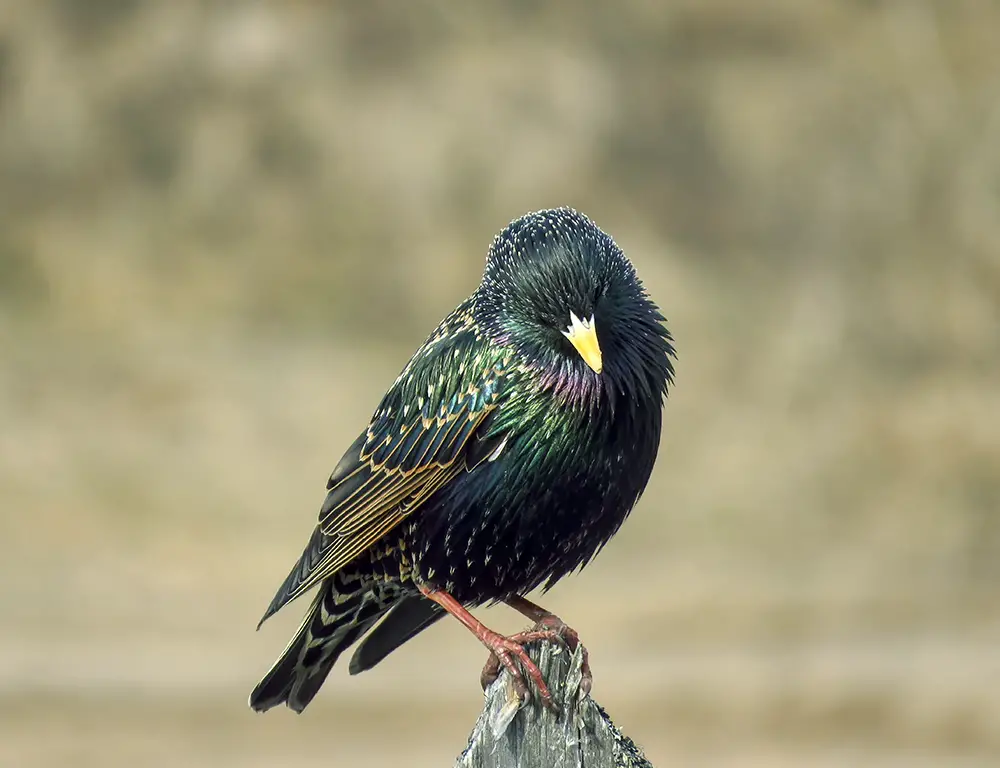
How to Identify Starling?
Identifying a starling might seem challenging at first glance due to its seemingly plain appearance, but with a closer look and attention to detail, you can distinguish this bird from others.
Starlings belong to the family Sturnidae and are known for their gregarious behavior and remarkable vocal abilities. Here are some of the key points to help you identify a starling:
Size and Shape
Starlings are small to medium-sized birds, measuring 8 to 9 inches (20 to 23 cm) in length. They have a stocky build, short, triangular wings, and a relatively short tail. Their bodies appear somewhat rounded when perched.
Plumage
While starlings may appear black from a distance, a closer look reveals a glossy iridescence to their plumage.
Their feathers shimmer with shades of green, purple, and bronze, particularly during the breeding season. However, in non-breeding plumage, they may appear duller, with more muted colors.
Bill
Starlings have a slender, pointed bill that is slightly yellowish during the breeding season. Outside of the breeding season, their bills may appear darker. The bill is relatively long compared to the size of their head.
Eyes
The eyes of a starling are dark and relatively small in proportion to the size of their head. They often appear shiny and give the bird a keen, intelligent expression.
Behavior
Starlings are highly social birds and often congregate in large flocks, especially during the non-breeding season. Their flight patterns are swift and agile, with rapid wingbeats and sudden changes in direction.
Vocalizations
One of the most distinctive features of starlings is their impressive vocal repertoire.
They are proficient mimics and can imitate the calls of other birds and various sounds, including human-made noises. Their songs are often complex and harmonious.
Habitat
Starlings are adaptable birds found in various habitats, including urban areas, farmland, woodlands, and grasslands.
They are commonly seen foraging for food in open fields or on lawns, probing the ground with their bills for insects and other invertebrates.
Range
Regarding geographical distribution, starlings are native to Europe, Asia, and North Africa.
However, they have been introduced to many other parts of the world, including North America, Australia, and New Zealand, where they are often considered invasive due to their aggressive behavior and negative impact on native bird species.
By paying attention to these key characteristics, you can confidently identify a starling and appreciate its unique beauty and behavior.
Taxonomy and Classification of Starling
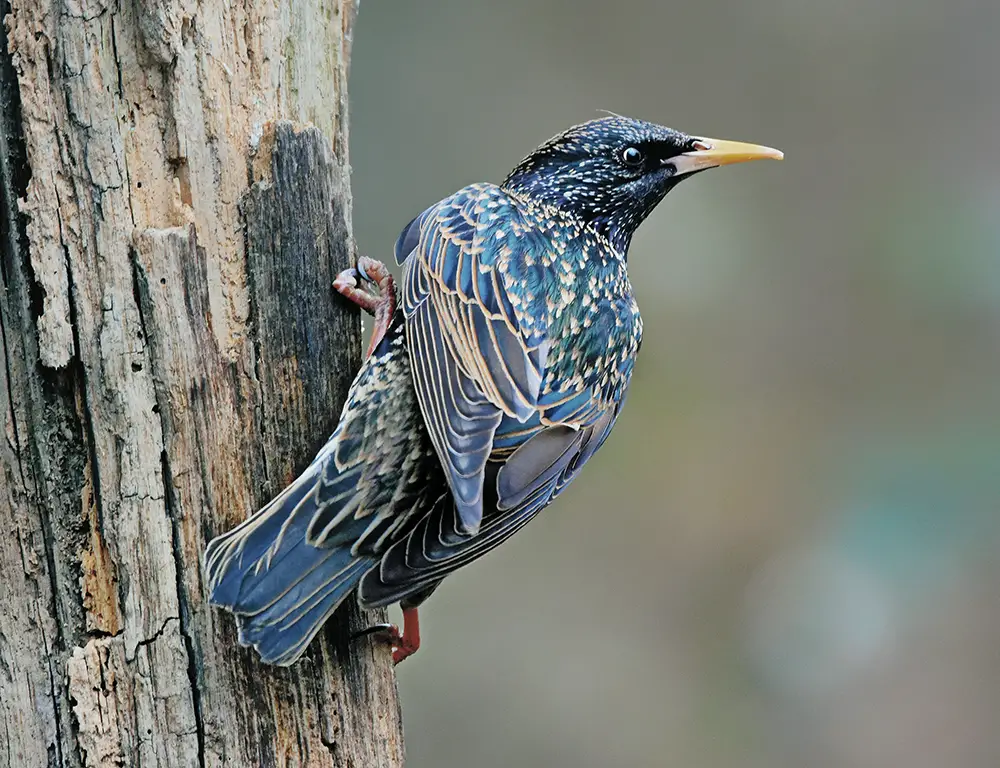
The common starling, scientifically known as Sturnus vulgaris, belongs to the kingdom Animalia, phylum Chordata, class Aves, order Passeriformes, and family Sturnidae.
It is a passerine bird species widely distributed across Europe, Asia, and North Africa, with introduced populations established in other parts of the world.
Here’s an excellent table detailing the taxonomy of the common starling:
| Kingdom | Animalia |
| Phylum | Chordata |
| Class | Aves |
| Order | Passeriformes |
| Family | Sturnidae |
| Genus | Sturnus |
| Species | S. vulgaris |
| Common Name | Common Starling |
This table outlines the hierarchical classification of the common starling, ranging from the broadest taxonomic kingdom category down to the specific species level.
It provides a systematic framework for understanding the evolutionary relationships of this bird within the broader context of avian biodiversity.
The common starling, Sturnus vulgaris, exhibits notable diversity across its vast range, leading to the recognition of several subspecies.
These subspecies demonstrate variations in plumage coloration, size, and geographical distribution.
While the taxonomy and number of recognized subspecies may vary among different authorities, here are some of the commonly acknowledged subspecies:
- Sturnus vulgaris vulgaris: This subspecies, often called the European Starling, is found across much of Europe, including the British Isles, Scandinavia, and continental Europe. It typically exhibits a glossy black plumage with iridescent green and purple tones, particularly during the breeding season.
- Sturnus vulgaris zetlandicus: Also known as the Shetland Starling, this subspecies is restricted to the Shetland Islands off the northern coast of Scotland. It tends to be slightly smaller and darker than the mainland European starlings, with a more uniform black plumage.
- Sturnus vulgaris faroensis: Found in the Faroe Islands in the North Atlantic, this subspecies, known as the Faroese Starling, is characterized by its smaller size and darker plumage compared to continental European starlings. It often exhibits a more brownish tone to its feathers.
- Sturnus vulgaris poltaratskyi: This subspecies, commonly known as the Central Asian Starling, inhabits parts of Central Asia, including Kazakhstan and Uzbekistan. It tends to have paler plumage compared to European starlings and less pronounced iridescence.
- Sturnus vulgaris purpurascens: The Purple-backed Starling, as it is sometimes called, is found in parts of the Middle East, including Israel, Jordan, and Saudi Arabia. It is characterized by its rich purple and green iridescence on the back and wings, adding a vibrant splash of color to its appearance.
- Sturnus vulgaris porphyronotus: Found in parts of eastern Asia, including China, Japan, and Korea, this subspecies, known as the Purple-backed Starling or Asian Glossy Starling, exhibits similar plumage characteristics to its Middle Eastern counterpart, with vibrant purple and green hues on the back and wings.
These are just a few examples of the diverse subspecies of the common starling across its extensive range.
Each subspecies has adapted to its specific geographical region, exhibiting unique traits and characteristics shaped by local environmental conditions and evolutionary history.
Behavior and Social Structure of Starling
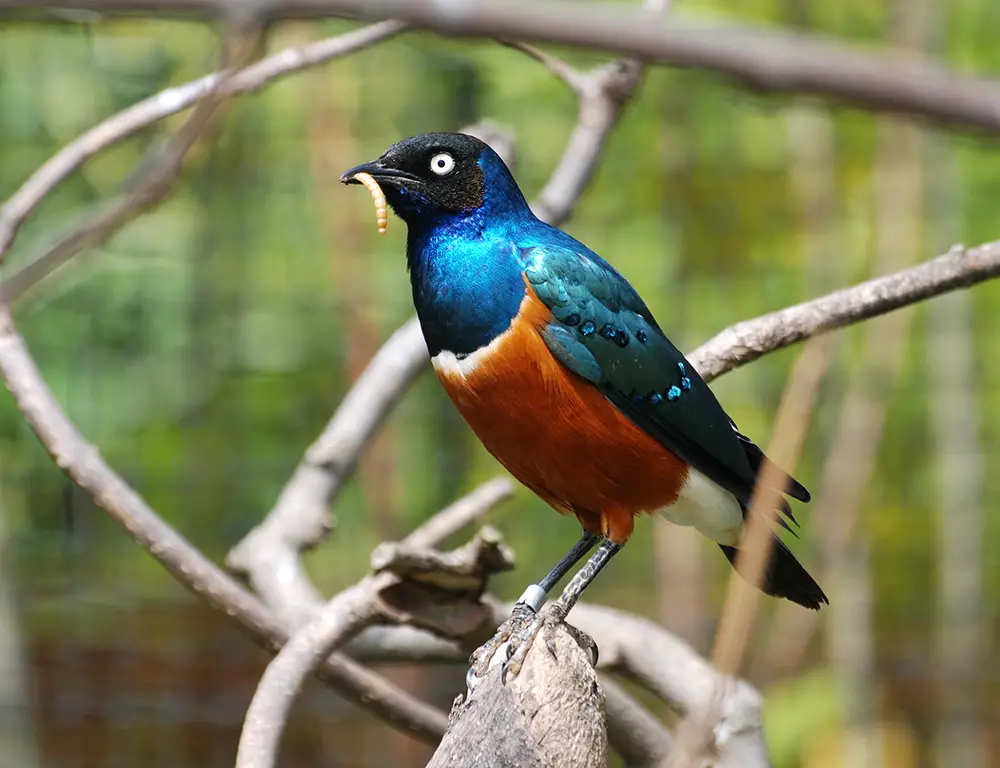
The common starling (Sturnus vulgaris) is renowned for its complex social behavior and remarkable adaptability, contributing to its success as a species. Here’s an overview of the behavior and social structure of starlings:
Gregarious Nature
Starlings are highly social birds that often gather in large flocks, particularly outside the breeding season.
These flocks can consist of hundreds or even thousands of individuals and serve various purposes, including foraging, roosting, and protection from predators.
Roosting Behavior
At dusk, starlings congregate in communal roosts, often in dense vegetation or urban structures such as buildings and bridges.
These roosts can be huge, with thousands of birds coming together in a synchronized display called a murmuration.
During murmurations, starlings perform intricate aerial maneuvers, creating mesmerizing patterns in the sky.
Breeding Behavior
While starlings are gregarious outside the breeding season, they become more territorial and solitary during the breeding season.
Males establish territories and engage in courtship displays to attract females. These displays often involve singing and aerial acrobatics.
Nesting
Starlings typically nest in cavities, including tree hollows, buildings, and nest boxes. They are known to be opportunistic nesters, readily adopting artificial structures for nesting purposes.
The female constructs the nest using grasses, twigs, and other plant materials, often lining it with feathers or other soft materials.
Parental Care
Both parents participate in incubating the eggs and feeding the nestlings.
Starlings provide their young with a diverse diet, including insects, fruits, seeds, and even scraps of human food scavenged from urban areas.
Vocalizations
Starlings are accomplished vocal mimics and can imitate a wide range of sounds, including the calls of other bird species and human-made noises such as car alarms and cell phone ringtones.
They use vocalizations to communicate within the flock, during courtship, and defend territories.
Feeding Behavior
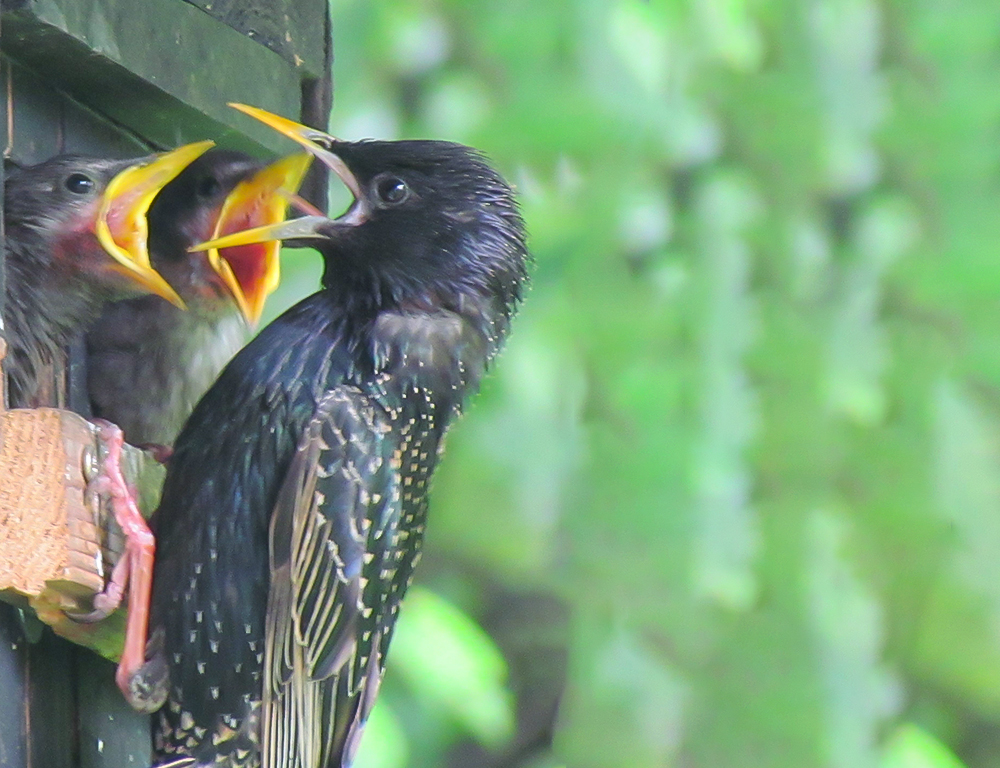
Starlings are omnivorous birds with a varied diet. They primarily feed on insects and other invertebrates during the breeding season but switch to a more plant-based diet outside the breeding season, including fruits and seeds.
They are often seen foraging on the ground, probing the soil with their bills in search of food.
Migration
While some populations of starlings are sedentary, others undertake seasonal migrations, particularly in regions with harsh winter conditions.
These migrations can involve long-distance movements, with some birds traveling thousands of kilometers to reach their wintering grounds.
Starlings’ behavior and social structure reflect their adaptability and resilience as a species, allowing them to thrive in a wide range of habitats and environmental conditions.
Reproduction and Life Cycle of Starling
The reproduction and life cycle of the common starling (Sturnus vulgaris) follow a typical pattern for passerine birds, characterized by seasonal breeding, nest-building, incubation, and parental care.
Here’s an overview of the reproduction and life cycle of starlings:
Breeding Season
The breeding season for starlings typically begins in late winter or early spring, but it varies somewhat depending on geographical location and local climate conditions.
Migratory populations may begin breeding later upon reaching their breeding grounds.
Courtship and Pair Formation
During breeding, male starlings establish territories and engage in elaborate courtship displays to attract females. These displays often involve singing, puffing up of feathers, and aerial acrobatics.
Once a pair bond is formed, the male and female select a suitable nesting site.
Nest Building
Starlings are cavity nesters and will utilize a variety of natural and artificial structures for nesting, including tree hollows, buildings, and nest boxes.
The female is primarily responsible for constructing the nest, typically made of grasses, twigs, and other plant materials, lined with softer materials such as feathers and moss.
Egg Laying and Incubation
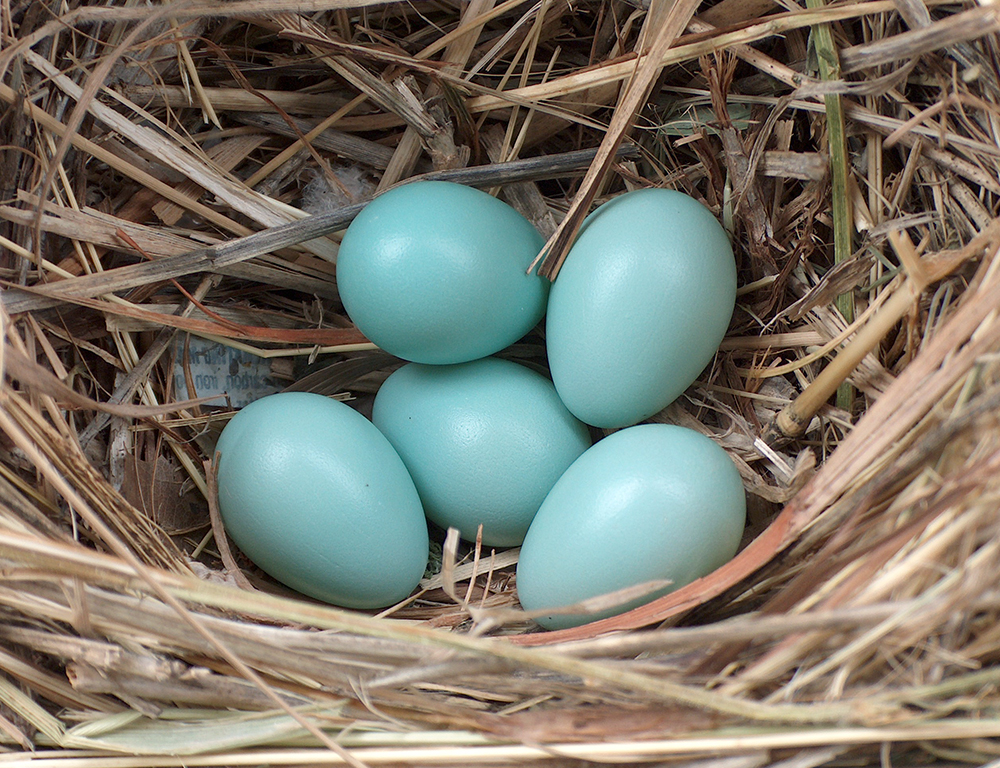
The female starling typically lays a clutch of 4 to 6 eggs, although sizes vary. She incubates the eggs for about 12 to 14 days, during which time the male may assist with incubation duties by bringing food to the female.
Hatching and Nestling Stage
Once the eggs hatch, both parents actively feed and care for the nestlings. The nestlings are initially altricial, meaning they are born naked and helpless, requiring constant care and feeding from the parents.
The parents feed the nestlings a diet of insects and other small invertebrates.
Fledging
The nestlings remain in the nest for about 18 to 22 days before they fledge or leave. During this time, they rapidly develop their flight feathers in preparation for independent flight.
After fledging, the young birds are temporarily dependent on their parents for food and protection.
Post-Fledging Care
After fledging, the young starlings gradually become more independent but continue to rely on their parents for food and protection.
The parents continue to feed and care for the fledglings until they can fend for themselves and join the adult flock.
Subsequent Breeding Attempts
In favorable conditions, starlings may raise multiple broods in a single breeding season, with pairs often reusing the same nest site for subsequent clutches.
The life cycle of starlings is closely tied to seasonal changes in food availability and environmental conditions, with breeding activities timed to coincide with periods of abundance and favorable weather.
This reproductive strategy allows starlings to maximize their reproductive success and ensure the survival of their offspring.
Conservation Status and Threats for Starling
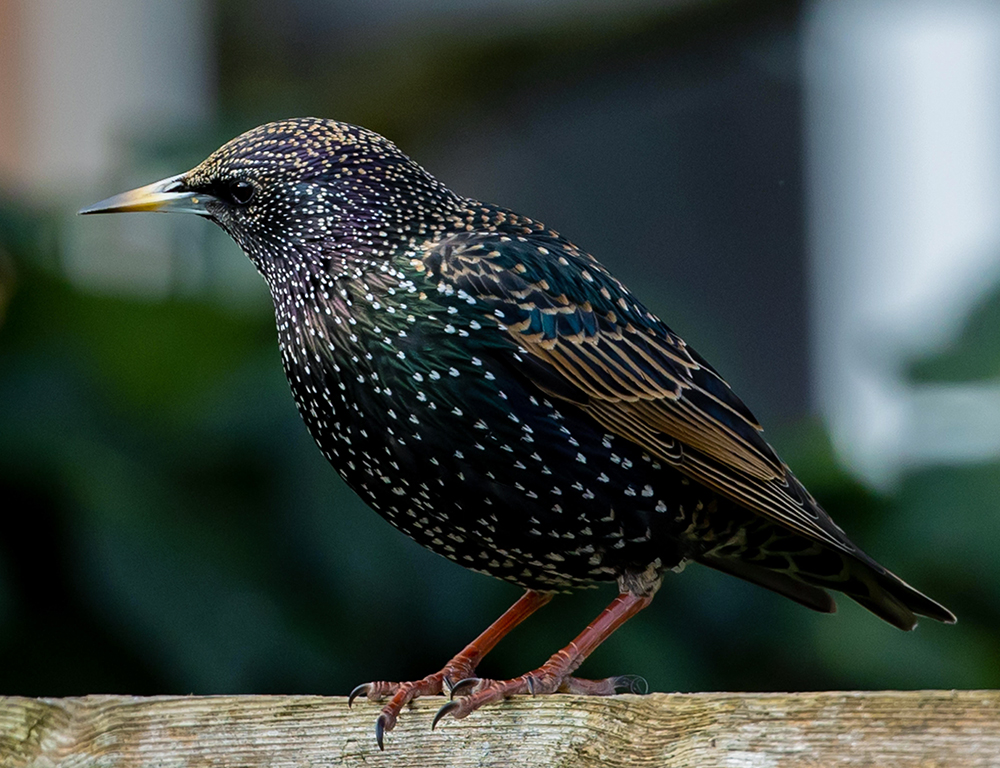
The common starling (Sturnus vulgaris) is listed as a species of “Least Concern” on the International Union for Conservation of Nature (IUCN) Red List.
However, despite this relatively stable conservation status, several threats and conservation concerns warrant attention:
Habitat Loss
Habitat loss and degradation due to urbanization, agricultural intensification, and deforestation are significant threats to starling populations.
Loss of nesting sites, such as old trees and natural cavities, can negatively impact breeding success.
Pesticides and Pollution
Starlings are vulnerable to the effects of pesticides and pollutants, particularly those used in agricultural areas.
Exposure to pesticides can lead to direct mortality or sublethal effects such as reduced reproductive success and compromised immune function.
Competition with Invasive Species
In some regions, starlings face competition for nesting sites and food resources from invasive species such as house sparrows (Passer domesticus) and European starlings (Sturnus vulgaris), which can negatively impact their populations.
Climate Change
Climate change threatens starlings through its effects on weather patterns, habitat suitability, and food availability.
Changes in temperature and precipitation regimes can disrupt breeding and migration patterns, affecting nesting timing and insect prey availability.
Predation
Starling nests and nestlings are vulnerable to predation by various predators, including birds of prey, mammals, and introduced species such as rats and cats.
Predation pressure can increase where natural predators are scarce, or nest sites are easily accessible.
Disease and Parasites
Starlings are susceptible to various diseases and parasites, including avian pox, avian influenza, and parasitic infestations.
Disease outbreaks can significantly impact local populations, particularly in areas where birds congregate in high densities.
Collision with Structures
Collisions with buildings, communication towers, and other structures threaten starlings, especially during nocturnal migrations or dense flocking behavior.
These collisions can result in injury or mortality, particularly for birds flying at high speeds.
Overhunting and Poaching
While not a significant threat in many regions, overhunting and poaching for food, sport, or pest control purposes can impact local starling populations, particularly in areas where hunting regulations are not adequately enforced.
Conservation efforts to address these threats include habitat conservation and restoration, pesticide regulation and mitigation measures, monitoring and research on population trends and ecology, and public education and awareness campaigns.
Addressing these threats and implementing targeted conservation actions can ensure the long-term survival of starling populations and maintain their critical ecological roles.
Wrapping Up
The common starling (Sturnus vulgaris) is a resilient and adaptable bird species, known for its complex social behavior, impressive vocal abilities, and remarkable adaptability to various habitats.
Despite facing threats such as habitat loss, pesticides, and competition with invasive species, concerted conservation efforts can help ensure the continued survival of starling populations.
By addressing these challenges and promoting habitat conservation, we can safeguard the future of this iconic bird species’ future and maintain their ecosystems’ ecological balance. Thank you so much.